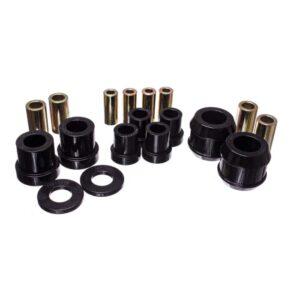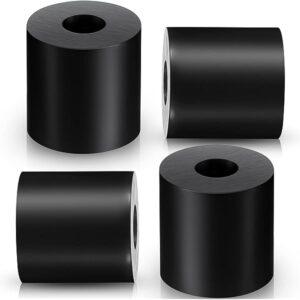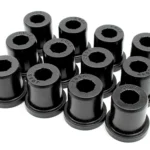Welcome again to Our New Blog on 'Rubber Bushes' let's start..
Introduction
This Blog article takes an in depth look at rubber bushings and their use.
You will learn more about topics such as:
- What is a Rubber Bushing?
- Types of Rubber Bushings
- How Rubber Bushings are Made
- Uses for Rubber Bushings
- Materials Used to Produce Rubber Bushings
- And Much More …

Now we Know, What is Rubber Bushes ?
A rubber bushing is a type of vibration isolator that is used to limit the motion between two components as well as to soak up, calm down, and buffer the energy generated by their contact. The most typical bushing is cylindrical with a hole in the centre, but they are extremely flexible tools that may be molded, designed, and moulded to match any sort of application.
In order to prevent wear and damage, linked elements must not move or vibrate, which is a crucial part of a rubber bushing’s function. Rubber bushings are a durable tool capable of withstanding severe stress and dramatic deformation, despite their tiny size and rubber construction.

Rubber bushings are made from synthetic rubber and natural rubber. The type of rubber determines how the bushing can be used since there are differences between the characteristics of natural rubber compared to synthetic rubber. Several types of rubber bushings are part of automobile manufacturing, which was their original use. They serve as a pivotal point due to their elastic and attenuation characteristics.
Types of Rubber Bushings....
Rubber bushings are needed for several types of equipment and machinery due to their stability and strength. Although they are an essential part of vehicles for their vibration suppression properties, other forms of machinery also use them for their nullifying characteristics in order to protect equipment from wear.
Types of rubber bushings vary in accordance with the hardness value of the rubber required to meet the needs of an application. Additionally, they vary in size to perfectly meet volume and static stiffness values.
While small and having a simple design, rubber bushings are an essential part of high stress applications. All bushings have a hollow interior used to separate metal connections and are made of soft absorbent materials. Aside from reducing vibrations, they are used as a method for sound and noise suppression.
Natural Rubber Bushings
Natural rubber bushings have high tensile strength and tear and fatigue resistance and are used for static or dynamic applications where noise and vibration suppression are necessary. The wide use of rubber bushings is due to their ability to withstand multiple impacts and still be able to offer optimal functioning. They have outstanding resilience with exceptional rebound elasticity as well as flexibility at low temperatures.
Regardless of natural rubber bushing’s positive characteristics, they should not be used for high temperature applications or be exposed to the ozone, oil, and hydrocarbon solvents. Operating temperatures should not exceed 155o F, and cylindrical style mounts cannot be used for tension applications.

Conical Bushing
Conical rubber bushings are made from silicone rubber with a lower compression set. The silicone material is able to withstand radically high temperatures and is compatible with oil and grease. Conical bushings are also known as rubber cone bushings and are suitable for compression and shearing loads with a fail safe capacity and high load capacity. They are widely used in automotive and marine applications.

Leaf spring bushings are used on the front eye of automotive springs and can be encased in steel or be all rubber. They provide a cushion for all the springs on a vehicle with ones on the front encased in steel while in the rear they are all rubber. Leaf spring equalizer bushings support the ends of leaf springs and allow them to articulate. They have a center bushing that helps cushion shock on the vehicle’s frame.
Leaf Spring Bushings

Leaf spring bushings are used on the front eye of automotive springs and can be encased in steel or be all rubber. They provide a cushion for all the springs on a vehicle with ones on the front encased in steel while in the rear they are all rubber. Leaf spring equalizer bushings support the ends of leaf springs and allow them to articulate. They have a center bushing that helps cushion shock on the vehicle’s frame.
Manufacturing Process
Material Choice: Rubber and metal are frequently combined to create bushings. Because of their high strength of tensile, flexibility, and resistance to the elements, synthetic rubber compounds are preferred.
The rubber is shaped by molding it into the appropriate shape, which might be cylindrical, conical, or tailored to meet particular needs.
Bonding: During the molding process, metal sleeves or inserts are placed inside the rubber. These inserts offer connection locations as well as structural support.
Vulcanization: The molded rubber is heated and compressed during the vulcanization process, increasing its elasticity and tensile strength.
Materials Used
Natural Rubber: Derived from the latex of rubber trees, natural rubber offers excellent flexibility and resilience, making it ideal for a wide range of applications.
Synthetic Rubber: Compounds like neoprene, nitrile, and silicone rubber are used for their specific properties, such as oil resistance, temperature tolerance, and longevity.
Metal Inserts: Commonly made from steel or aluminum, metal inserts provide stability, strength, and a secure attachment point.
Conclusion
Rubber bushings may seem quiet, but there is no denying their influence on the functionality, comfort, and safety of a vehicle. These adaptable parts are crucial in many sectors, from regulating suspension movement to lowering noise and vibrations. Understanding the many types, uses, manufacturing procedures, and components that go into rubber bushings helps us better appreciate how important they are to making travel both on and off the road comfortable and pleasurable.

